![]()
![]()
![]()
Use LEFT and RIGHT arrow keys to navigate between flashcards;
Use UP and DOWN arrow keys to flip the card;
H to show hint;
A reads text to speech;
37 Cards in this Set
- Front
- Back
|
Difference between satellite and in-transit mets? |
Satellite is within 2cm of the lesion
Mets is >2cm of the lesion |
|
|
Difference between micromets and macromets? |
Macromets are clinically palpable |
|
|
What is the only modifiable risk factor for melanoma? |
history of a blistering sunburn |
|
|
Mutation in giant congenital nevi --> melanoma? |
NRAS |
|
|
Mutation in spitz nevi --> melanoma? |
HRAS |
|
|
Most commonly mutated oncogene in melanoma? |
BRAF |
|
|
Mutation usually seen in superficial spreading melanoma? |
BRAF |
|
|
Mutation in blue nevi --> melanoma? |
GNAQ/GNA11 |
|
|
Mutation in uveal melanoma? |
GNAQ/GNA11 |
|
|
What is BAP-1? |
BRCA1 associated protein-1
BAP1 is a member of the ubiquitin C-terminal hydrolases (UCH) subfamily of deubiquitylating enzymes (DUBs) and was mutated in each family member who had developed mesothelioma, uveal or cutaneous melanomas, renal cell carcinoma
This is 'wiesners nevus' |
|
|
Draw out the melanomagenesis pathway... |
DO IT NOW |
|
|
This is mutated in 40% of melanomas and is associated with invasion? |
PTEN |
|
|
Where is BRAF typically mutated? |
V600E |
|
|
mutation in melanoma that is mucosal? |
ckit |
|
|
mutation in acral lentiginous melanoma? |
ckit |
|
|
mutation in chronically sundamaged skin (lentigo)? |
ckit |
|
|
Where does uveal melanoma most often metastasize to? |
LIVER |
|
|
CDKN2A is in 25-40% of hereditary causes of melanoma... what other cancer do you need to look out for? |
PANCREATIC |
|
|
the veil on dermoscopy over a MM is suggestive of what pathologically? |
scarring in the papillary dermis |
|
|
What stains can be used to diagnose melanoma? |
MART-1, Melan-A, MITF, HMB-45, Ki-67, P16, Sox-10, S100 |
|
|
TQ: 11p gain? |
Spitz nevi |
|
|
Surgical treatment of melanoma:
thickness in situ <1mm 1-4mm >4mm |
in situ --> 0.5cm margins <1mm --> 1.0cm margins 1-4mm --> 2.0cm margins >4mm --> 2.0-3.0cm margins |
|
|
MOA of vemurafenib? Side effects? |
BRAF inhibitor- cutaneous squamous cell carcinoma, KA, photosensitivity, arthralgia, rash, nausea, alopecia, fatigue, pruritis, palmar plantar syndrome, keratosis pilaris
look at all this crap.... this is why its only indicated for metastatic melanoma or unresectable stage III melanoma |
|
|
MOA of dabrafenib? Side effects? |
BRAF inhibitor- cutaneous squamous cell carcinoma, KA, photosensitivity, arthralgia, rash, nausea, alopecia, fatigue, pruritis, palmar plantar syndrome, keratosis pilaris, INCLUDES PYREXIA |
|
|
Most common cancer to metastasize to the brain? |
LUNG (19.9%), melanoma (6.9%) |
|
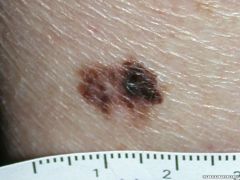
mutation? |
superficial spreading melanoma
BRAF |
|
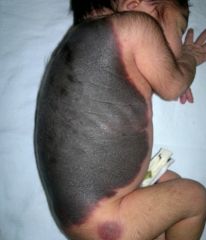
mutation? |
GIANT CONGENITAL NEVUS
NRAS |
|

mutation? |
blue nevus
GNAQ/GNA11 |
|
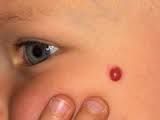
MUTATION? |
spitz nevus
HRAS |
|
|
Gingers have a mutation in... |
MC1R
blocks melanocortin and makes a light phenotype |
|
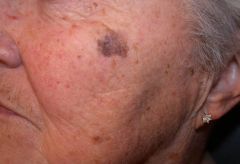
mutation? |
lentigo maligna melanoma
c-kit mutation
imatinib and sunitinib are c kit inhibitors
**remember LMM, mucosal melanoma and acral melanomas are all c-kit |
|
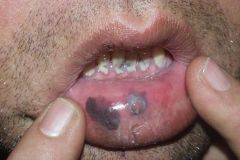
mutation? |
mucosal melanoma
c kit
imatinib and sunitinib are c kit inhibitors
**remember LMM, mucosal melanoma and acral melanomas are all c-kit |
|

mutation? |
acral melanoma
c kit
imatinib and sunitinib are c kit inhibitors
**remember LMM, mucosal melanoma and acral melanomas are all c-kit |
|
|
MOA of ipilimumab? |
blocks CTLA4
CTLA is an immune checkpoint molecule that down regulates T cell activation, so when it's blocked, T cells go cray cray
**remember, this is why your patient got patches of vitiligo after taking ipilimumab |
|
|
MOA of trametinib? |
MEK inhibitor |
|
|
MOA of imatinib? |
c-kit inhibitor |
|
|
CDK4 is dysregulated in what percent of melanomas? |
90% |

